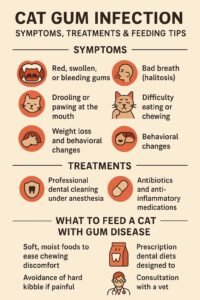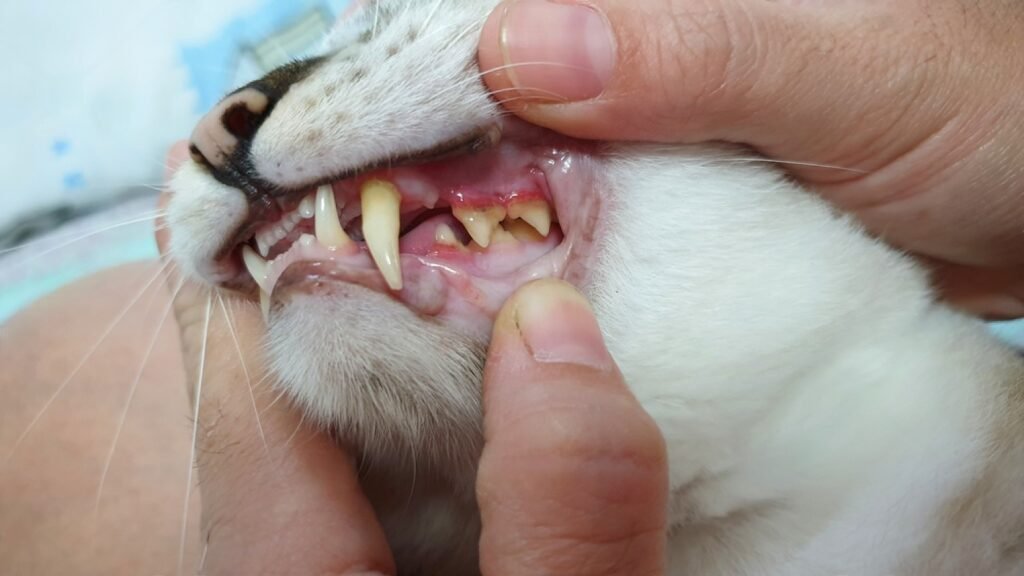Did you know that up to 85% of cats over the age of three suffer from some form of dental disease, including gum infections? Feline gum disease is one of the most common yet often overlooked health issues in cats. Left untreated, it can lead to chronic pain, tooth loss, and even affect vital organs like the heart and kidneys.
Cat gum infections typically begin with a silent invader: plaque buildup. Over time, this sticky film hardens into tartar, inflaming the gums and opening the door to infections. Terms like gingivitis (early-stage inflammation), periodontal disease (advanced gum and tooth damage), and stomatitis (severe oral inflammation) often come up when discussing feline dental health.

Cat Gum Infection: Understanding Gingivitis and Periodontal Disease
Cat gum infections are a prevalent yet often overlooked health issue. They typically begin with the accumulation of plaque—a sticky film composed of bacteria, food particles, and saliva—on the teeth. If not removed through regular dental care, plaque hardens into tartar, leading to inflammation of the gums, known as gingivitis.
Gingivitis: The Reversible Stage
Gingivitis is the initial stage of gum disease, characterized by red, swollen gums that may bleed during brushing or eating. At this point, the condition is still reversible with proper dental hygiene and professional care. Regular brushing and dental cleanings can effectively manage and reverse gingivitis.
Vet and Tech
Periodontal Disease: The Irreversible Progression
If gingivitis isn’t addressed in time, it can advance into periodontal disease — a more serious, long-term condition. This stage impacts not only the gums but also the deeper structures that hold the teeth in place, such as the ligaments and jawbone. Over time, this can result in permanent damage and tooth loss. This stage often requires more intensive veterinary interventions to manage.
Merck Veterinary Manual
The Importance of Early Detection
Early detection and treatment of gum disease are crucial in preventing its progression. Regular dental check-ups, proper oral hygiene, and a balanced diet can help maintain your cat’s dental health and overall well-being.
Cat Gum Infection Symptoms
Spotting a gum infection early can make a big difference in your cat’s comfort and long-term health. While symptoms may start off subtle, they often become more obvious as the condition worsens. Keep an eye out for these common signs:
- Red, swollen, or bleeding gums – Often visible when your cat yawns or eats, these are early warning signs of gingivitis.
- Bad breath (halitosis) – A foul odor from the mouth usually signals a bacterial buildup.
- Drooling or pawing at the mouth – These behaviors may indicate pain or irritation in the gums.
- Difficulty eating or chewing – You might notice your cat avoiding dry food or chewing on one side.
- Weight loss and behavioral changes – Cats in oral discomfort may eat less, become irritable, or withdraw from usual activities.
Causes of Gum Disease in Cats
Gum disease in cats doesn’t happen overnight—it’s usually the result of several contributing factors. Understanding these causes can help you take steps to prevent it before it starts.
- Plaque and tartar buildup – The most common cause is plaque forming after meals and hardening into tartar, leading to gum inflammation.
- Poor oral hygiene – Without regular brushing or dental care, harmful bacteria thrive in your cat’s mouth.
- Dietary factors – Soft or wet food can stick to teeth more easily than dry kibble, increasing the risk of plaque.
- Underlying health conditions – Cats with FIV, FeLV, or diabetes are more prone to gum infections due to weakened immune systems.
- Genetic predispositions – Certain breeds like Siamese, Persians, and Abyssinians may be more vulnerable to dental issues.
Cat Gum Infection Home Remedies
While professional veterinary care is essential for treating advanced gum disease in cats, certain home remedies can help manage early-stage gingivitis and support overall oral health. It’s important to consult with your veterinarian before starting any home treatment to ensure it’s appropriate for your cat’s specific condition.
Daily Dental Hygiene
Brushing your cat’s teeth consistently is one of the best methods to reduce plaque and maintain healthy gums. Use a cat-specific toothbrush and toothpaste, as human products can be harmful to cats. If brushing isn’t feasible, consider using dental wipes or Veterinary Oral Health Council (VOHC)-approved dental treats to help reduce plaque and tartar accumulation.
Antibacterial Oral Rinses
Chlorhexidine-based oral rinses can help control bacteria in the mouth. These rinses are typically applied directly to the gums or added to your cat’s drinking water, but it’s crucial to follow your veterinarian’s instructions for proper use.
Natural Soothing Agents
Certain natural substances may help soothe inflamed gums:
- Coconut oil: Known for its antimicrobial properties, coconut oil can be gently applied to your cat’s gums to reduce inflammation.
- Herbal remedies: Herbs like chamomile, calendula, and aloe vera have anti-inflammatory properties and may provide relief when applied appropriately.
- Vitamin C: This vitamin supports the immune system and may aid in gum health. However, consult your vet before supplementing, as excessive amounts can be harmful.
Dental Diets and Chews
Specially formulated dental diets and chews can assist in reducing plaque and tartar. These products are designed to clean the teeth mechanically as the cat chews, promoting better oral hygiene.
Supplements and Additives
Some supplements and water additives are designed to promote oral health:
- Propolis: A natural resin with antibacterial properties that may help in managing oral bacteria.
- Omega-3 fatty acids: These can support overall gum health and reduce inflammation.
- Dental water additives: Products added to drinking water to help control plaque and freshen breath.
Incorporating these home remedies can support your cat’s oral health, but they should complement, not replace, professional veterinary care. Regular dental check-ups are essential to monitor and maintain your cat’s gum health.
Gum Disease in Cats: Understanding the Risks and Prevention
Gum disease, or periodontal disease, is a prevalent issue in cats, affecting up to 85% of felines over the age of three. It begins with plaque accumulation, which, if left untreated, can progress to gingivitis and eventually periodontitis. This progression can lead to tooth loss, chronic pain, and systemic health problems.

What Is Periodontal Disease?
Periodontal disease starts when plaque, a sticky film of bacteria, accumulates on the teeth. If not removed, it hardens into tartar, leading to gingivitis, characterized by red, swollen gums. Without intervention, the condition can advance to periodontitis, where the structures supporting the teeth become damaged, potentially resulting in tooth loss and bone deterioration.
Health Risks Associated with Gum Disease
Gum disease doesn’t just stay confined to the mouth—its impact can reach the entire body. When harmful bacteria from inflamed gums enter the bloodstream, they may travel to key organs like the heart, liver, and kidneys, potentially causing serious health issues. This highlights why addressing dental problems early is crucial for your cat’s overall well-being.
Diagnosis and Treatment
Veterinarians diagnose periodontal disease through oral examinations and dental X-rays to assess the extent of the condition. Treatment typically involves professional dental cleaning under anesthesia to remove plaque and tartar. In advanced stages, removing one or more teeth might be required to relieve pain and prevent further oral complications. Post-treatment, maintaining oral hygiene through regular brushing and dental check-ups is crucial to prevent recurrence.
Prevention Strategies
Preventing gum disease involves a combination of professional care and at-home practices:
- Regular Dental Check-ups: Routine veterinary visits for dental assessments can catch early signs of gum disease.
- Daily Brushing: Using a cat-safe toothpaste to brush your feline’s teeth can effectively clear away plaque buildup before it turns into stubborn tartar.
- Dental Diets and Treats: Providing dental-specific diets and treats can aid in reducing plaque accumulation.
- Water Additives: These can help control bacterial growth in the mouth, supporting overall oral health.
What to Feed a Cat with Gum Disease
Feeding a cat with gum disease requires careful consideration to ease their discomfort and support their oral health. Since cats with gingivitis or periodontal disease often experience pain while chewing, adjusting their diet can make a significant difference in both comfort and recovery. Here’s what pet parents should know:
Soft, Moist Foods for Gentle Eating
Soft or wet food is generally easier for cats with sore gums to chew and swallow. Choose pâtés or minced varieties instead of chunks to reduce chewing effort. These textures are less likely to irritate inflamed gums and help prevent your cat from avoiding meals due to oral pain.
Prescription Dental Diets
Veterinarians may recommend dental-specific diets such as Hill’s® Prescription Diet t/d or Royal Canin Dental. These are formulated to help reduce plaque and tartar buildup even when cats chew minimally. Some of these diets use a unique kibble texture or include antibacterial ingredients that benefit oral hygiene (PetMD).
Avoid Hard Kibble if Painful
While some dry foods are designed to clean teeth, they may cause more harm than good for cats already dealing with gum sensitivity. If your cat shows signs of pain or avoids eating kibble, it’s best to switch to softer options until their mouth heals or a vet provides alternative recommendations.
Talk to Your Vet About Personalized Nutrition
Each cat has unique needs, so a solution that benefits one might not be suitable for another. Your veterinarian can assess the severity of the gum disease and suggest a custom feeding plan based on your cat’s age, dental condition, and overall health. In some cases, additional supplements or probiotics may be included to boost oral and digestive wellness.
Real-Life Story: Moses’ Journey to Better Dental Health
HannahS, a cat owner from New Zealand, shared her experience on the Holistic Actions forum about her 13-year-old cat, Moses. Moses had suffered from bad breath for most of his life, and his demeanor was notably irritable; he would only allow petting on the top of his head and would scratch or hiss if touched elsewhere.
After years of concern and minimal veterinary acknowledgment, HannahS decided to switch Moses to a raw food diet. The change led to significant improvements: Moses’ bad breath diminished, and his temperament became noticeably more affectionate. He began to enjoy full-body pets without aggression, indicating a substantial reduction in discomfort.
Holistic Actions!
This transformation suggests that dietary changes, such as introducing a raw food diet, can have a profound impact on a cat’s oral health and overall well-being. However, it’s essential to consult with a veterinarian before making significant dietary adjustments to ensure they meet your cat’s specific health needs.
Conclusion
Feline gum disease is more than just a dental issue—it’s a serious health concern that can impact your cat’s overall well-being. From early-stage gingivitis to advanced periodontal disease, untreated oral conditions can lead to chronic pain, tooth loss, and even systemic complications affecting major organs.
Noticing early indicators like inflamed gums, foul breath, or trouble chewing is crucial for catching dental issues before they worsen. Timely veterinary care, combined with at-home dental routines and proper nutrition, plays a critical role in managing and reducing the risk of gum infections.
To safeguard your cat’s health, schedule regular dental check-ups, consider dental-specific diets, and practice consistent oral hygiene. Proactive care not only improves your cat’s quality of life but also helps prevent costly treatments down the line. Prioritizing dental health is an essential part of responsible pet ownership, and your cat depends on you for it.







